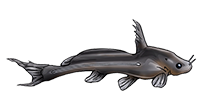Devaere, S, D Adriaens, GG Teugels & W Verraes, 2005. Morphology and spatial constraints in a dorso-ventrally flattened skull, with a revised species description of Platyallabes tihoni (Poll, 1944). Journal of Natural History 39: 1653-1673.
Abstract
This study details the morphology of Platyallabes tihoni (Poll, 1944) as part of a complete revision of the anguilliform clariids. The overall body form of air-breathing clariids ranges from fusiform to anguilliform genera (Boulenger 1911; Pellegrin 1927). Although P. tihoni has the typical external morphological features of other elongate clariids, this study shows that it occupies an intermediate position between fusiform and anguilliform taxa with regards to its cranial and postcranial morphology. The main morphological similarities of anguilliform species are a narrow skull roof with a high level of interdigitation between the bones, the reduced canal bones, a connection between the neurocranium and suspensorium via several processes, an extended tooth patch on the lower jaw, and the hypertrophied jaw muscle complex. Shared features typical for the fusiform species are a low coronoid process on the lower jaw and the posteroventral orientation of the opercular process on the hyomandibula. Platyallabes tihoni shows a series of unique features: an anterior fontanel situated entirely between the frontals, two tooth plates on the prevomer, a reduced height of the suspensorium, the absence of an anterior bony plate on the hyomandibula, a horizontal position of the sphenotic and pterotic, and a toothed entopterygoid. Many of these unique characters are linked to the spatial constraints associated with an extremely flattened skull in this species.
Platyallabes
- Silurus
- Posts: 12420
- Joined: 31 Dec 2002, 11:35
- I've donated: $12.00!
- My articles: 55
- My images: 893
- My catfish: 1
- My cats species list: 90 (i:1, k:0)
- Spotted: 424
- Location 1: Singapore
- Location 2: Moderator Emeritus





